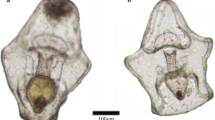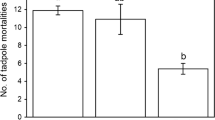Abstract
Dytiscus sharpi is defined as “Critically Endangered” in the Red List of Japan and designated as a “nationally endangered species of wild fauna and flora” of the Japanese “Conservation of Endangered Species of Wild Fauna and Flora” Act. In previous studies, tadpoles of Red List species (Rana ornativentris) were collected, and approximately 300 tadpoles were needed to raise one D. sharpi adult. A rearing experiment was performed to identify alternative prey for D. sharpi larvae. Larvae were reared on cultivable prey (Asellus hilgendorfii, goldfish, and crickets), and the quality of alternative prey was compared to that of tadpoles based on three criteria: adult size, survival rate, and development speed. Adult size, survival rate, and development speed values showed that alternative prey, i.e., A. hilgendorfii, goldfish, and crickets, were of adequate quality as larval prey according to all monitored parameters when compared to tadpoles. Dytiscus sharpi larvae can be raised using only cultivable prey, and multiple choices are available. The elimination of the need to overcollect endangered tadpoles from the field by using alternative prey for rearing will contribute to the conservation of both D. sharpi and R. ornativentris. This result would make ex-situ conservation of D. sharpi sustainable.
Implications for insect conservation
Furthering the ex-situ conservation of D. sharpi by using A. hilgendorfii, goldfish, and crickets as alternative prey, will contribute to the conservation of not only D. sharpi but also of the tadpoles of R. ornativentris.






Similar content being viewed by others

References
Culler LE, Ohba S, Crumrine P (2014) Predator-prey interactions of Dytiscids. In: Yee DA (ed) Ecology, Systematics, and the natural history of predaceous diving beetles (Coleoptera: Dytiscidae), pp 363 – 386. Springer, Dordrecht. https://doi.org/10.1007/978-94-017-9109-0_8
Foster GN, Bilton DT (2014) The conservation of predaceous diving beetles: knowns, unknowns and anecdotes. In: Yee DA (ed) Ecology, Systematics, and the natural history of predaceous diving beetles (Coleoptera: Dytiscidae). Springer, Dordrecht, pp 437–462. https://doi.org/10.1007/978-94-017-9109-0_11
Fukuoka T, Tamura R, Yamasaki S, Ohba SY (2023) Effects of different prey on larval growth in the diving beetle Cybister sugillatus Erichson, 1834 (Coleoptera: Dytiscidae), Aquat Insects. https://doi.org/10.1080/01650424.2022.2141259
Hayashi M (2020) Laboratory rearing of Hyphydrus japonicus Sharp (Coleoptera: Dytiscidae). Bull Hoshizaki Green Found 23:51–59 (in Japanese)
Hayashi M, Nakajima J, Ishida K, Kitano T, Yoshitomi H (2020) Species diversity of aquatic Hemiptera and Coleoptera in Japan. Jpn J Syst Entomol 26:191–200
Houlahan JE, Findlay CS, Schmidt BR, Meyer AH, Kuzmin SL (2000) Quantitative evidence for global amphibian population declines. Nature 404:752–755. https://doi.org/10.1038/35008052
Inoda T (2012) Predaceous diving beetle, Dytiscus sharpi sharpi (Coleoptera: Dytiscidae) larvae avoid cannibalism by recognizing prey. Zool Sci 29:547–552. https://doi.org/10.2108/zsj.29.547
Inoda T, Kamimura S (2015) Choice of prey body parts for effective feeding by predaceous diving beetle larvae, Dytiscus sharpi sharpi (Wehncke) (Coleoptera: Dytiscidae). J Insect Behav 28:26–36. https://doi.org/10.1007/s10905-014-9475-z
Inoda T, Kitano T (2013) Mass breeding larvae of the critically endangered diving beetles Dytiscus sharpi sharpi and Dytiscus sharpi validus (Coleoptera: Dytiscidae). Appl Entomol Zool 48:397–401. https://doi.org/10.1007/s13355-013-0176-4
Inoda T, Hasegawa M, Kamimura S, Hori M (2009) Dietary program for rearing the larvae of a diving beetle, Dytiscus sharpi (Wehncke), in the laboratory (Coleoptera: Dytiscidae). Coleopt Bull 63:340–350. https://doi.org/10.1649/1152.1
International Union for Conservation of Nature (2022) The IUCN Red List of Threatened Species, Version 2022-1. https://www.iucnredlist.org/. Accessed 15 October 2022
Jäch MA, Balke M (2008) Global diversity of water beetles (Coleoptera) in freshwater. Hydrobiologia 595:419–442
Kitano T, Watanabe K (2016) Ex situ preservation the last resort to avoid extinction. Nat Insects 51(7):24–27 (in Japanese)
Kuwabara T, Morinaga K, Nakahata K (2022a) [Reproduction of Hydaticus bowringii (Clark, 1864) under rearing condition.] Kankyo Syufuku Project Houkokusyo. Hoshizaki Green Found 2021:27–31
Kuwabara T, Morinaga K, Nakahata K (2022b) [Reproduction of Graphoderus adamsii Clark, 1864 under rearing condition.] Kankyo Syufuku Project Houkokusyo. Hoshizaki Green Found 2021:33–38
Ministry of the Environment of Japan (2022) List of nationally endangered species of wild fauna and flora (In Japanese). https://www.env.go.jp/nature/kisho/domestic/list.html. Accessed 16 October 2022
Ministry of the Environment of Japan (2015) Red data book 2014 – threatened wildlife of Japan, vol 5. Insecta, Gyosei Corporation, Tokyo. (in Japanese)
Nakajima J, Hayashi M, Ishida K, Kitano T, Yoshitomi H (2020) Aquatic Coleoptera and Hemiptera of Japan. Bun-ichi Sogo shuppan, Tokyo. (in Japanese)
Nishihara S (2012) Analysis of freshwater animal community by field experiment and its application to conservation. Japanese J Conserv Ecol 62:179–186. https://doi.org/10.18960/seitai.62.2_179(in Japanese)
Nishihara S (2013) Conservation of aquatic insects — the results during the last decade and the problem for future. Nat Insects 48(4):20–23 (in Japanese)
Ohba S (2009a) Feeding habits of the diving beetle larvae, Cybister brevis Aubé (Coleoptera: Dytiscidae) in japanese wetlands. Appl Entomol Zool 44:447–453. https://doi.org/10.1303/aez.2009.447
Ohba S (2009b) Ontogenetic dietary shift in the larvae of Cybister japonicus (Coleoptera: Dytiscidae) in japanese rice fields. Environ Entomol 38:856–860. https://doi.org/10.1603/022.038.0339
Okuno H, Kubota H, Nakajima M, Sasaji H (1996) Life history of Acilius kishii Nakane (Coleoptera: Dityscidae [sic]). Spec Publ Entomol Soc Fukui 1:1–53 (in Japanese)
R Core Team (2020) R: a language and environment for statistical computing. R Foundation for Statistical Computing, Vienna. https://www.r-project.org/
Sánchez-Bayo F, Wyckhuys KAG (2019) Worldwide decline of the entomofauna: a review of its drivers. Biol Conserv 232:8–27. https://doi.org/10.1016/j.biocon.2019.01.020
Short AEZ (2018) Systematics of aquatic beetles (Coleoptera): current state and future directions. Syst Entomol 43:1–18. https://doi.org/10.1111/syen.12270
Tomisawa A (2001) Breeding the diving beetle, Dytiscus sharpi validus. Anim Zoos 53:276–279 (in Japanese)
Tomisawa A (2011) Breeding the diving beetle, Dytiscus sharpi and Cybister lewisianus. Tokkuribachi 7:2–11 (in Japanese)
Vahrushev V (2011) Technological aspects of keeping Dytiscus latissimus Linnaeus, 1758 (Coleoptera: Dytiscidae) in laboratory conditions. Acta Biol Univ Daugavpiliensis 11:201–218
Watanabe K (2020) Biological notes on Hyphydrus laeviventris Sharp, 1882 (Coleoptera, Dytiscidae). Elytra N S 10:351–355
Watanabe K (2021) Biology of the small diving beetle Laccophilus yoshitomii Watanabe and Kamite, 2018 (Coleoptera: Dytiscidae) and rearing methods. Coleopt Bull 75:88–92. https://doi.org/10.1649/0010-065X-75.1.88
Watanabe K (2022) Biological notes on immature stages of Platambus ussuriensis (Nilsson, 1997) and Copelatus nakamurai Guéorguiev, 1970 (Coleoptera: Dytiscidae). Coleopt Bull 76:233–236. https://doi.org/10.1649/0010-065X-76.2.233
Watanabe K, Hayashi M (2019) Reproductive ecology and immature stages of Copelatus masculinus Régimbart, 1899 (Coleoptera, Dytiscidae). Elytra N S 9:269–278
Watanabe K, Kato M (2017) Reproductive ecology of Hydaticus satoi Wewalka, 1975 under rearing condition. Sayabane N S 25:36–41 (in Japanese)
Watanabe K, Hayashi M, Kato M (2017a) Immature stages and reproductive ecology of Copelatus parallelus Zimmermann, 1920 (Coleoptera, Dytiscidae). Elytra N S 7:361–374
Watanabe K, Suda M, Fukutomi H (2017b) Efficient breeding method of diving beetles for ex situ conservation: focusing on Acilius kishii Nakane, 1963. Sayabane N S 27:6–12 (in Japanese)
Watanabe R, Ohba SY, Yokoi T (2020) Feeding habits of the endangered japanese diving beetle Hydaticus bowringii (Coleoptera: Dytiscidae) larvae in paddy fields and implications for its conservation. Eur J Entomol 117:430–441. https://doi.org/10.14411/eje.2020.047
Watanabe K, Inoda T, Suda M, Yoshida W (2021) Larval rearing methods for two endangered species of diving beetle, Cybister chinensis Motschulsky, 1854 and Cybister lewisianus Sharp, 1873 (Coleoptera: Dytiscidae), using laboratory-bred food prey. Coleopt Bull 75:440–444. https://doi.org/10.1649/0010-065X-75.2.440
Watanabe K, Saiki R, Suda M, Yoshida W (2022a) Biological notes on immature stages of Hydaticus pacificus conspersus (Coleoptera: Dytiscidae). Can Entomol 154:E19. https://doi.org/10.4039/tce.2022.8
Watanabe K, Saiki R, Sumikawa T, Yoshida W (2022b) Rearing method for the endangered species Dineutus mellyi mellyi Régimbart, 1882 (Coleoptera: Gyrinidae). Aquat Insects. https://doi.org/10.1080/01650424.2022.2107676
Yamasaki S, Watanabe K, Ohba SY (2022) Larval feeding habits of the large-bodied diving beetle Cybister rugosus (Coleoptera: Dytiscidae) under laboratory conditions. Entomol Sci 25:e12510. https://doi.org/10.1111/ens.12510
Acknowledgements
We express our sincere gratitude to Mr. Hirokazu Fukutomi (Ishikawa Insect Museum) for helping secure prey. We would also like to thank Editage (www.editage.jp) for English language editing.
Author information
Authors and Affiliations
Contributions
Kohei Watanabe was involved in the study conception, design, rearing, data collection for laboratory experiments, and data analysis. Tomoki Sumikawa was involved in rearing and data collection for laboratory experiments. The first draft of the manuscript was written by Kohei Watanabe and all authors have read and approved the final version of the manuscript.
Corresponding author
Ethics declarations
Competing interests
The authors did not receive support from any organization for the work submitted.
Additional information
Publisher’s Note
Springer Nature remains neutral with regard to jurisdictional claims in published maps and institutional affiliations.
Rights and permissions
Springer Nature or its licensor (e.g. a society or other partner) holds exclusive rights to this article under a publishing agreement with the author(s) or other rightsholder(s); author self-archiving of the accepted manuscript version of this article is solely governed by the terms of such publishing agreement and applicable law.
About this article
Cite this article
Watanabe, K., Sumikawa, T. Larval prey options for the endangered species Dytiscus sharpi (Coleoptera: Dytiscidae: Dytiscinae) for sustainable ex-situ conservation. J Insect Conserv 27, 895–905 (2023). https://doi.org/10.1007/s10841-023-00506-7
Received:
Accepted:
Published:
Issue Date:
DOI: https://doi.org/10.1007/s10841-023-00506-7



